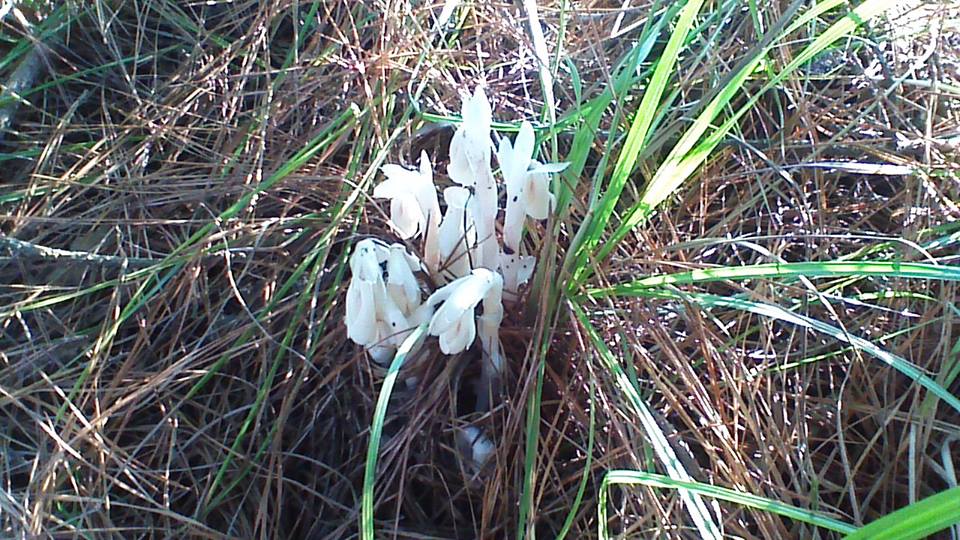
by Carrie Stevenson | Jan 5, 2018
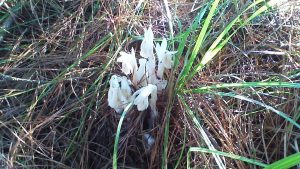
The ghost flower in full bloom. Photo credit: Carol Lord
Imagine you are enjoying perfect fall weather on a hike with your family, when suddenly you come upon a ghost. Translucent white, small and creeping out of the ground behind a tree, you stop and look closer to figure out what it is you’ve just seen. In such an environment, the “ghost” you might come across is the perennial wildflower known as the ghost plant (Monotropa uniflora, also known as Indian pipe). Maybe it’s not the same spirit from the creepy story during last night’s campfire, but it’s quite unexpected, nonetheless. The plant is an unusual shade of white because it does not photosynthesize like most plants, and therefore does not create cholorophyll needed for green leaves.
In deeply shaded forests, a thick layer of fallen leaves, dead branches, and even decaying animals forms a thick mulch around tree bases. This humus layer is warm and holds moisture, creating the perfect environment for mushrooms and other fungi to grow. Because there is very little sunlight filtering down to the forest floor, the ghost flower plant adapted to this shady, wet environment by parasitizing the fungi growing in the woods. Ghost plants and their close relatives are known as mycotrophs (myco: fungus, troph: feeding).
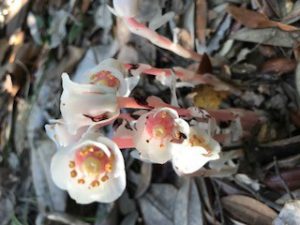
Ghost plant in bloom at Naval Live Oaks reservation in Gulf Breeze, Florida. Photo credit: Shelley W. Johnson
These plants were once called saprophytes (sapro: rotten, phyte: plant), with the assumption that they fed directly on decaying matter in the same way as fungi. They even look like mushrooms when emerging from the soil. However, research has shown the relationship is much more complex. While many trees have symbiotic relationships with fungi living among their root systems, the mycotrophs actually capitalize on that relationship, tapping into in the flow of carbon between trees and fungi and taking their nutrients.
Mycotrophs grow throughout the United States except in the southwest and Rockies, although they are a somewhat rare find. The ghost plant is mostly a translucent shade of white, but has some pale pink and black spots. The flower points down when it emerges (looking like its “pipe” nickname) but opens up and releases seed as it matures. They are usually found in a cluster of several blooms.
The next time you explore the forests around you, look down—you just might see a ghost!
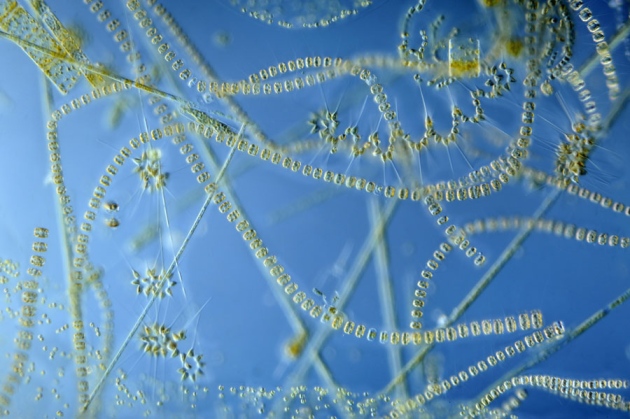
by Rick O'Connor | Jan 5, 2018
Last year I began a series of articles on the Gulf of Mexico. They focused on the physical Gulf – water, currents, and the ocean floor. This year the articles will focus on the life within the Gulf, and there is a lot of it.
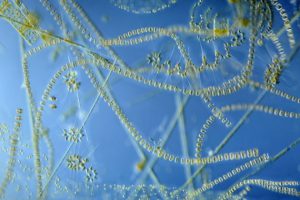
Single celled algae are the “grasses of the sea” and provide the base of most marine food chains.
Photo: University of New Hampshire
We will begin with the base of food web systems, the simplest creatures in the sea. The base of food systems are generally plants and the simplest of these are the single celled plants. Singled celled plants are a form of algae, not true plants in the sense we think of them, but serving the same role in the environment – which is the production of much needed energy.
What these single celled algae need to survive is the same as the more commonly known plants – sunlight, water, carbon dioxide, oxygen, and nutrients.
Sunlight is difficult for marine plants because sunlight only penetrates so deep. Therefore, marine plants and algae must live in shallow water, or have some mechanism to remain near the surface in the open sea. In relation to their overall body volume, smaller creatures have more surface area than larger ones. More surface area helps resist sinking and the smallest you can get is a single cell. Thus, most marine algae are single celled. Many single celled plants are encased in transparent shells that have spines and other adaptations to assist in increasing their surface area and keeping them near the surface. Some actually have drops of oil (buoyant in water) making it even easier to stay near the surface. These small floating algae drift in the surface currents, and drifting organisms are called plankton. Plankton that are “plant-like” are called phytoplankton.
The next needed resource is water; the Gulf and Bay are full of it. However, saltwater is not what they need – freshwater is, so they must desalinate the water before absorbing it. They can do this by adjusting the solutes within their cytoplasm. The greater the ratio of surface area is to volume, the more diffusion of solutes can take place – thus these small phytoplankton are very good at diffusing resources in (like water and carbon dioxide) and expelling waste (like ammonia and oxygen).
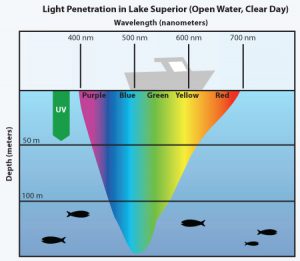
Image showing how deep different colors of light penetrates in the sea.
Image: Minnesota Sea Grant
Carbon dioxide and oxygen are dissolved in seawater and, like water, are diffused into the phytoplankton. Warmer water holds less oxygen so there would be a tendency to have more phytoplankton in colder waters. However, warmer waters are so because there is generally more sunlight, a needed resource. The colder, sunlit, surface waters off some coasts – such as California – have higher amounts of dissolved oxygen and are some of the most productive areas in the ocean. Phytoplankton can also serve as “carbon sinks” by removing carbon dioxide dissolved in the seawater coming from the atmosphere. However, this may not be the answer to excessive CO2 in the atmosphere because, like all creatures, you can only consume so much “food”. Excessive loads of carbon dioxide will not be consumed.
Finally, there is the need for nutrients. All plants need fertilizer. Nutrients in the sea come from either run-off from land, or decayed material from the ocean floor. Much of the nutrients are discharged into the Gulf by run-off from land. Because of this, much of the phytoplankton are congregated nearshore where rivers meet the sea. We think of marine life as equally distributed across the ocean, but in act it is not, there is more life nearshore. For the compost on the ocean floor to be of used by phytoplankton, it must reach the surface. This happens where a current called an upwelling occurs. Upwellings rise from the seafloor bringing with them the nutrients. Where upwellings occur, the seawater is colder, and sunlight abundant, you have the greatest concentration of marine life – all fueled by these phytoplankton.
In the Gulf, one of the most productive places is “the plume”, where the Mississippi River discharges. This massive river brings water, sediments, and nutrients, from most of the continent. The large plankton blooms attract massive schools of plankton consuming fish, predatory fish, sea birds, and marine mammals.
In the next post, we discuss some of the different phytoplankton that inhabit our coastal waters and the amazing things they do.
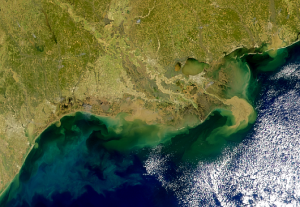
A satellite image showing the sediment plume of the Mississippi River. This plume brings with it nutrients that fuel plankton blooms.
Image: NASA satellite
References
Kirst G.O. (1996) Osmotic Adjustment in Phytoplankton and MacroAlgae. In: Kiene R.P., Visscher P.T.,
Keller M.D., Kirst G.O. (eds) Biological and Environmental Chemistry of DMSP and Related Sulfonium Compounds. Springer, Boston, MA
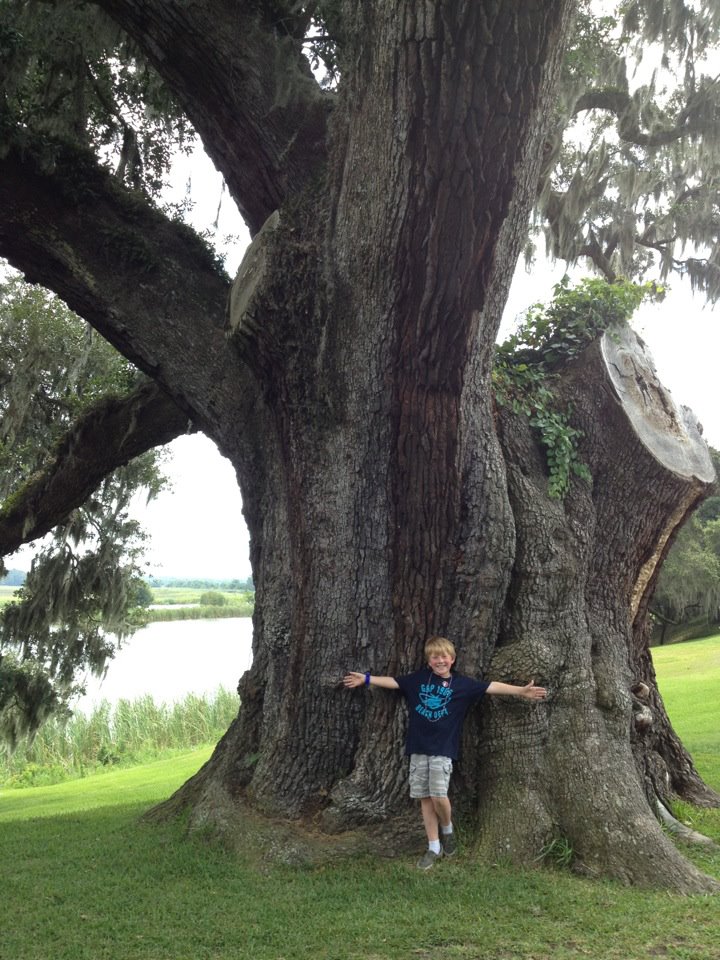
by Carrie Stevenson | Jan 5, 2018
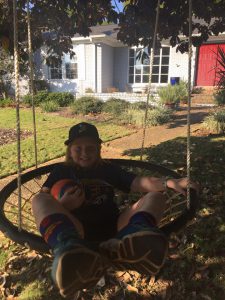
The swing hanging from our magnolia tree has provided many happy memories for our family. Photo credit: Carrie Stevenson
Do you have a favorite tree? Often, the trees in our lives tell a story.
One of the selling points when we bought our house 14 years ago was the tall, healthy Southern magnolia in the front yard. It was beautiful, and I could see it out my front window. A perfect shade tree, I could envision a swing hanging from its branches one day. Within six months of moving into the house, Hurricane Ivan struck. A neighbor’s tree fell and sheared off a quarter of the branches from our beloved magnolia. We were lucky to have minimal damage otherwise, and hoped the tree would survive.
The branches and leaves eventually filled in, and we added that swing I had imagined. One day I was pushing my daughter in the swing, when a car slowed on our street and stopped at our mailbox. A man stepped out and asked, “Are you enjoying that tree?” I responded that we very much were, and with a smile, he explained that his family built our house and that he planted that very magnolia tree 40 years before, when his son was born. He was so happy to see us enjoying the tree that he could not help but stop.
I was so grateful to hear that story and know that our family’s favorite tree held such special meaning. Our enjoyment existed because of the joyous celebration of a new birth. That is why we plant trees. For the benefit of those yet unborn, to commemorate special moments, and to provide the very oxygen we breathe. As the Greek proverb goes, “Society grows great when old men plant trees whose shade they know they shall never sit in.”
January 19 is Florida’s Arbor Day, a time to celebrate the many benefits of trees, and the day is often celebrated by planting new trees. Winter is the best time of year to plant trees, as they are able to establish roots without competing with the energy needs of new branches and leaves that come along in springtime.
“The best time to plant a tree is twenty years ago. The second best time is now.” –Anonymous
Check with your local Extension offices, garden clubs, and municipalities to find out if there is an Arbor Day event near you! Several local agencies have joined forces to organize tree giveaway events in observance of Florida’s Arbor Day.
Escambia County:
Thursday, January 18:
Deadline for UF IFAS Extension/Escambia County’s second annual Arbor Day Mail Art Contest. To participate, mail a drawing, painting, or mixed media artwork with the theme, “Strong Trees, Strong Communities” to Arbor Day Art Contest c/o Escambia County Extension, 3740 Stefani Road, Cantonment, FL 32533. Please include your name, age, and contact information on the back of your artwork. Contest entries must arrive by mail or be dropped off by Jan. 18 and will be judged at the tree giveaway on Jan. 20 at Barrineau Park Community Center.
First place winners of the art contest will receive prizes including a seven-gallon tree, a shovel, and a tree book. Second place winners will receive a tree book and third place winners will receive gardening gloves. Categories include children (12-under), teen (13-18), and adult (over 18). All participants in attendance at the tree giveaway will receive a special edition Arbor Day water bottle featuring last year’s winning design.
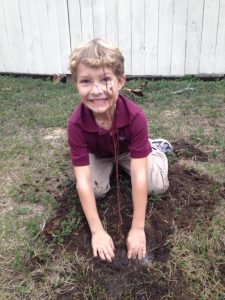
Many communities plant trees to celebrate Arbor Day. Photo credit: Carrie Stevenson
Saturday, January 20th
Escambia County will hold their tree giveaway and public planting from 10 a.m. to noon Saturday, Jan. 20 at Barrineau Park Community Center, located at 6055 Barrineau Park Road, Molino. Support for the event is provided by the Florida Forest Service, Resource Management Services, and Escambia County UF-IFAS Extension. Each attendee will receive two free native 1-gallon trees. Species available include tulip poplar, Chickasaw plum, Shumard oak, and fringetree.
For more information about either Escambia event, contact Carrie Stevenson, Coastal Sustainability Agent III, UF IFAS Extension, at 850-475-5230 or ctsteven@ufl.edu.
Santa Rosa County:
Friday, January 19
10 am—Navarre Garden Club Arbor Day celebration. Foresters will give away 1-gallon containerized trees and conduct a have tree planting demo. 7254 Navarre Parkway, Navarre, 32566. For more information, contact Mary Salinas, 850-623-3868 or maryd@santarosa.fl.gov
Saturday, January 20th
10 am—Milton Garden Club Arbor Day celebration. Foresters will give away 1-gallon containerized trees and conduct a have tree planting demo. 5256 Alabama Street, Milton. For more information, contact Mary Salinas, 850-623-3868 or maryd@santarosa.fl.gov
Leon County:
Saturday, January 20th
9am to 12pm – City of Tallahassee/Leon County Arbor Day Celebration – Join City and County Staff, UF/IFAS Leon County Extension Faculty and Master Gardener volunteers at the Apalachee Regional Park (7550 Apalachee Pkwy) for a tree planting in honor of Arbor Day. Citizens are invited to come help plant hundreds of trees in the park and also learn about the benefits of trees, how to properly plant a tree, and after the planting is done, take a tree identification walk. For more information, contact Mindy Mohrman, City/County Urban Forester at 850.891.6415 or melinda.mohrman@talgov.com










